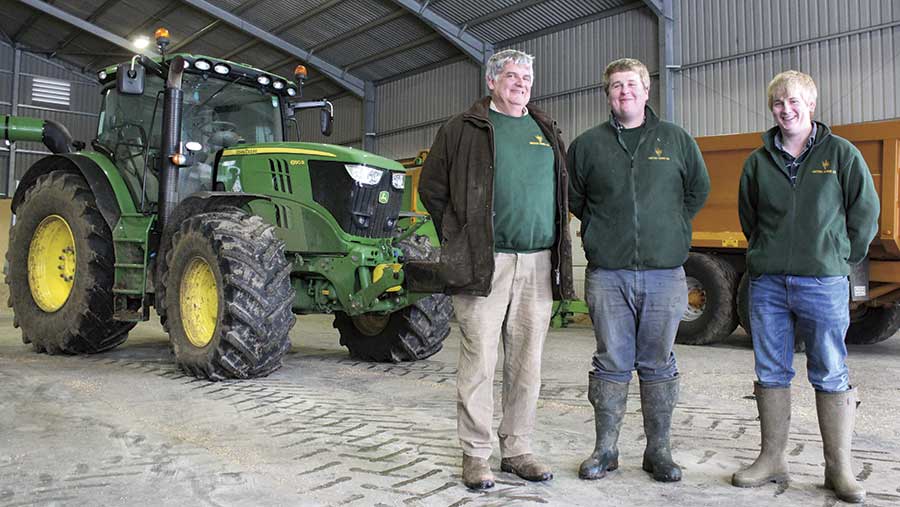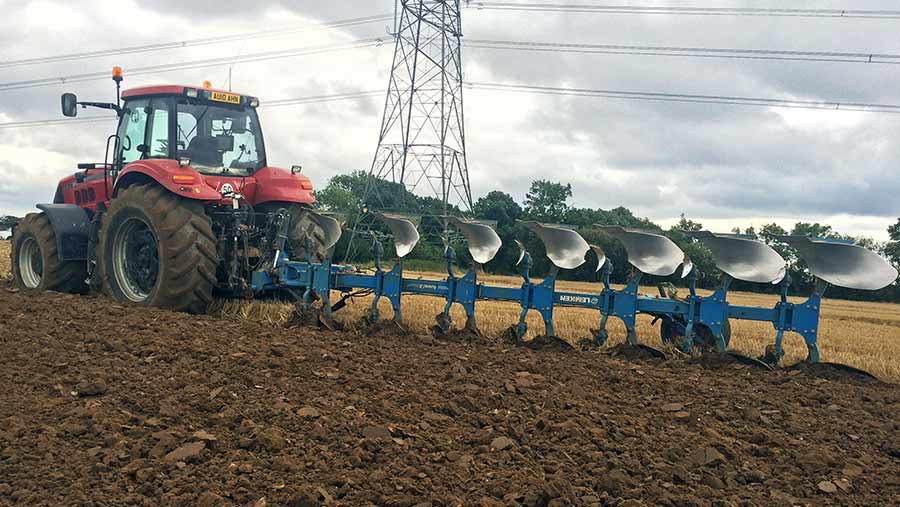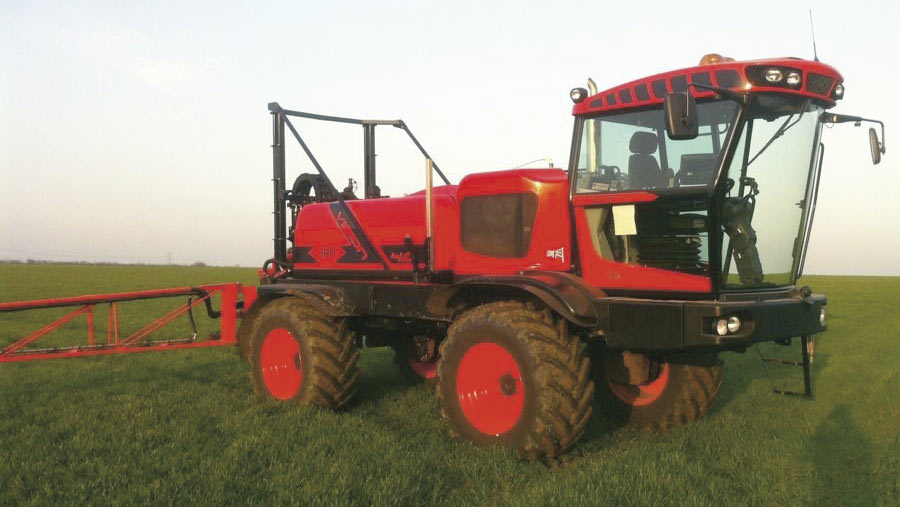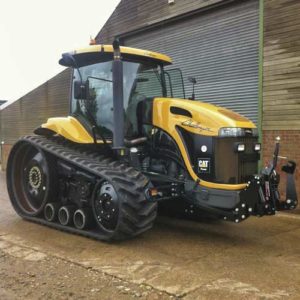What’s In Your Shed? Norfolk arable farm opens its doors
Norfolk farmer Michael King, along with sons Josh and Isaac, is the latest to reveal the contents of his machinery shed.
The family farms 350ha, plus another 350ha on stubble-to-stubble contracts and has a mixed-brand tractor fleet that includes a John Deere, Challenger and Case Magnum.
Their favourite kit includes the Greenstar guidance system, while the Magnum recently racked-up a £13,000 bill after the front axle hub chewed itself to bits.

Michael King and sons Josh and Isaac
How loyal are you to individual brands?
We’re fortunate in that we’ve always had a lot of big dealers on our doorstep, which has stopped us becoming particularly attached to a single brand.
See also: What’s in Your Shed? visits a Herefordshire contractor
We tend to try and weigh up the options before parting with any cash – hence why there are Case, Challenger and John Deere tractors sat in the shed.
That said, we’re beginning to lean towards Deere, simply because the Greenstar system is so easy to use.
Farm facts
Necton Farms, Necton, Swaffham, Norfolk
- Farmed area 350ha, plus 350ha stubble-to-stubble contracts
- Cropping 335ha winter wheat, 120ha oilseed rape, 100ha sugar beet, 80ha winter beans, 50ha winter barley, 15ha spring barley
- Staff Michael King, sister Caroline Tomkins and sons Josh and Isaac full time, plus a harvest student
Who is your favourite dealer and why?
Ben Burgess at Beeston is only five miles away and provides a great service.
Even if we have a calamity during harvest we can dump the breakdown in their yard and usually return to the farm with a loan machine to fill the hole.
Ernest Doe at Fakenham is also worth a mention and always has a well-stocked spare parts store.
Favourite piece of kit?
The Greenstar system has made a huge difference to the farm.
We’ve had Trimble straight-line guidance on the Challenger and Magnum for a long time, but ordering a John Deere 6190R with the full RTK GPS package a couple of years ago has turned out to be a complete game changer.
We’ve got two antennas for the tractor roof – one on RTK for drilling and another with the freebie SF1 signal we use for cultivations.
By our calculations, it will have paid for itself within the next year or two.
We knocked about 7% off our chemical bill straight away, as well as saving time and wearing metal during the autumn.

A Case IH Magnum 335 tractor with Lemken plough
Least favourite piece of kit?
We tend to get shot of anything that doesn’t perform, but we’ve had a few problems with the seven-furrow mounted Lemken plough that arrived new in 2013.
The plough itself is well built, but it’s too complicated and the electronics let it down.
A cable runs along the beam to the depth wheel for in-cab adjustments, but it gets damaged by clods and stone that fall as the plough turns.
Latest purchase? What do you think of it?
A Sulky fertiliser spreader arrived on the farm from Ernest Doe this winter.
It replaced a five-year-old Kuhn disc spreader that was perfectly good, but we wanted to move to auto-section control and get it singing with the Greenstar system rather than its own control box.
So far we’ve only spread a bit of P and K, but it seems to get on well with the Greenstar system and the 12-section shut-off will make the job far more accurate.
We’re also planning to start applying variable rates in the future.
Oldest piece of machinery still at work?
There are plenty of old-timers lying about, but the most regularly used is a 1999 JCB 530-70, which is now on 8,900 hours.
It was like new when we bought it on 5,000 hours from a straw contractor and now only clocks 300 hours a year shifting fertiliser, seed and grain.
It won’t pay to replace it, so we’ll have to make do with a new set of tyres instead.
How long do you keep your machines?
We’ve purposely avoided having any set replacement policy – we prefer to make the decision depending on how much it’s costing us to run, how good the alternatives are and what the wheat price is like.
In most cases, we shift machines when they begin to look tired and the repair bills get uneconomical.
Tractors typically stay for five years, but we’ve got a 2010 Magnum on 5,000 hours that we’re looking to change and a 2007 Challenger on 6,000 hours we’ve got no intention of selling.
What’s next on your wishlist?
We’ve got a long wishlist, but a pretty short shopping list.
A replacement for the Case Magnum is pretty high on the agenda – it’ll likely be a 300hp like-for-like trade, but for a John Deere equivalent because of the Greenstar.
We liked the 7R, which has a bigger rear lift than the Magnum – useful when you’re trying to pull a seven-furrow plough out of the ground.
Most embarrassing machinery mistake?
We’ve had a couple, but one of the worst was on Valentine’s Day five years ago when Josh caught the straining wire of a power line post while ploughing.
Luckily there was no fire, but it knocked out the power to the entire village and probably wrecked a few romantic meals.
Most expensive spare part you’ve had to buy?
One of the reasons for looking to shift the Magnum off the books is the repair bill we had in the autumn.
It had been reliable up until then, but the front hub decided to smash itself to bits while cultivating.
The rebuild, which had to be done in the field, cost £13,000 and was a clear hint that its time was up.
What’s your best invention?
We’re not big on workshop stuff – the best we’ve done is a frame to hold the slug pelleter.
What couldn’t you live without in the workshop?
The wheel changer has made life so much easier. It came from Spaldings along with a big 20t trolley jack and means we can switch between wide wheels and row crops in no time.
Do you buy second-hand?
We tend to buy the important stuff new because of the finance packages and warranty, but we’re not afraid of dipping into the second-hand market occasionally.

A Sands Vision sprayer
The combine came ex-demo on 100 hours a couple of years ago and the Challenger was well worn in by the time we’d got it.
Favourite job/least favourite job?
Combining has to be the favourite and there’s no doubt about the worst part – operating the 1970s grain store and dealing with it when things go wrong.
What’s your everyday transport?
We’ve always been big Land Rover fans and we’ve got a 110, as well as a few retired models tucked away.
We’re not interested in running Japanese pickups, so we’ll have to wait and see what happens – if anything – with the new Defender.
At the minute, the prices have gone mad, so we’ll be keeping the current one for a few years.
Best tractor you’ve ever had?
A Fendt LSA from the 1980s that, in its day, was streaks ahead of the competition.
It was a proper premium tractor and we kept it for 10 years and 8,000 hours, which was a lot in those days, but it hardly put a foot wrong.
Biggest machinery bargain?
A 6m Kuhn power harrow we bought second-hand eight years ago.
It sits on the Challenger and has a pretty hard life pulling down 200ha of beet ground each year, but it just keeps on going despite the whining gearbox.

A Cat Challenger 765B
We had to have one of the three gearboxes reconditioned a few years ago, but other than that and the usual spare parts, it’s hardly seen a spanner.
In comparison, our Amazone combination drill has had a gearbox rebuild and the bearings replaced in the space of five years.
What would you buy if you won the lottery?
Aside from some nice holidays, we’d have to knock down the old sheds and put up some decent replacements.
Any machinery toys/classics lurking in the shed?
A Ford 7610 that has been on the farm since new.
It used to lift all the sugar beet and do the spraying, but it has now been semi-retired to topping work.
We’ve also got a Series 1 Land Rover and a few other classics tucked away.
What’s in the shed?
- Tractors Cat Challenger 765B, Case IH Magnum 335, John Deere 6190R
- Combines John Deere S685
- Telehandler JCB 530-70
- Sprayers Sands Vision 4,000-litre, 24m self-propelled
- Fertiliser spreader Sulky X50+
- Cultivation kit Lemken seven-furrow plough, KV five-furrow plough, 3.5m Sumo subsoiler with OSR seeder, 6m Kuhn power-harrow, 4m He-Va discs, 12.3m He-Va rolls
- Drills 6m John Deere 750A, 6m Amazone Avant combination

